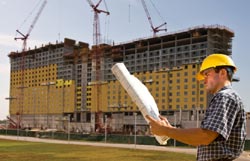Whole Building Air Tightness Testing

Air tightness testing is a process in which the building envelope is tested to quantify the air tightness. The test measures air leakage rates through a building envelope under controlled pressurization and depressurization. Air leakage of the envelope can be a quantitative value which can affect the durability of the building envelope, and energy efficiency and comfort of the entire building or house.
The only Canadian jurisdiction which requires blower door test as part of a code requirement is the City of Vancouver as part of their "Green Building Strategy" for one and two-family homes as part of the EnerGuide Rating System Audit. See their website for more information.
There are other non-code related incentive programs in the Canadian market for blower door testing including the R-2000 Program and the EnerGuide Rating System from Natural Resources Canada. Please contact your local energy utility for any incentive programs they may have which may include a blower door test.
Building testing is not a mandatory test prescribed in building codes for commercial buildings, but a performance-based option that many designers are requiring. The only requirements for whole building testing are in the State of Washington, the United States General Services Administration and all United States Army Corps of Engineers projects.
There are many standards worldwide that detail how to perform this test, some of these include:
- CAN/CGSB 149.15 - Determination of the Overall Envelope Airtightness of Buildings by the Fan Pressurization Method Using the Building's Air Handling Systems
- The United States Army Corps of Engineers Air Leakage Test Protocol for Building Envelopes
- ISO 9972:2006 - Thermal performance of buildings -- Determination of air permeability of buildings -- Fan pressurization method
- ASTM E779 - Standard Test Method for Determining Air Leakage Rate by Fan Pressurization
- ASTM E1827 - Standard Test Methods for Determining Airtightness of Buildings Using an Orifice Blower Door
- ATTMA - Measuring Air Permeance of Building Envelopes (Dwellings)
- ATTMA - Measuring Air Permeance of Building Envelopes (Non-Dwellings)
For more resources on whole building testing, please visit the Whole Building Design Guide (WBDG), a program from the National Institute of Building Science (NIBS) website at www.wbdg.org.
Red River College - Applied Research on Whole Building Air Leakage
In 2012, Red River College received financial support through the Natural Sciences and Engineering Research Council (NSERC) along with funding and in-kind support from Manitoba Hydro. RRC will be conducting research on improving the energy performance of buildings. As part of this study, they will be conducting whole building air leakage tests on 20 buildings in Winnipeg and southern Manitoba. For more information on this research, click here.
State & City Requirements for Whole Building Testing
Washington State Energy Code
Buildings over five stories require a whole building test but the code does not require the building to pass a prescribed value. For more details on this requirement, click here (see Chapter 13).
Seattle Energy Code
All Buildings require a whole building test conducted but the code requirement does not require the building to pass a prescribed value. For more details on this requirement, click here (see Chapter 13).
State of California Incorporates RESNET Air Tightness Testing Provisions Into Revised Energy Code
On May 31, 2012 The California Energy Commission (CEC) unanimously approved the revision of the state's energy efficiency standards for new homes and commercial buildings. As part of the revision of the energy code, the CEC incorporated the air tightness testing protocols established in RESNET's Chapter 8, "RESNET Standard for Performance Testing and Work Scope". The revised standard will take effect on January 1, 2014. For more information, please see the news release here.
United States Army Corps of Engineers (USACE)
The USACE and the US Navy requires all of their new and renovation construction projects meet a specific air tightness level based on testing to the Air Leakage Test Protocol for Building Envelopes. This protocol has been used to test up to 300 USACE and Navy buildings thus far. The USACE requires a maximum building envelope air leakage requirement of 0.25 CFM75/sq ft. The average result of air leakage testing of the USACE buildings is 0.16 CFM75/sq ft. To download a copy of the USACE Test Protocol for Building Envelopes, click here.
NABA Whole Building Air Tightness Testing - Air Leakage Unit Conversions spreadsheet
A spreadsheet has been developed for conversion of units typically found when conducting whole building air tightness testing.
Feel free to download and use this spreadsheet during the course of any work. Click here to download this spreadsheet. Any errors shall be reported to naba@naba.ca.
Airtightness Technical Resources & Publications
- TightVent Europe - the European portal for Airtightness of Buildings and Ductwork. For more information, news, publications and events please visit tightvent.eu
- TightVent Europe Newsletter September 2012 - The Observatoire BBC Examines Airtightness
